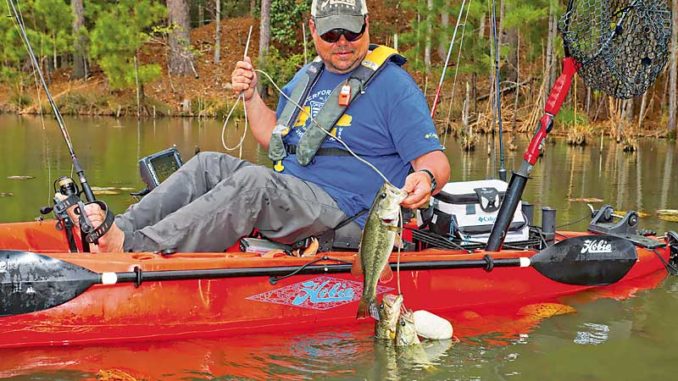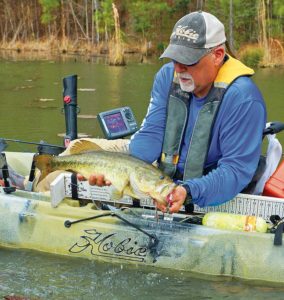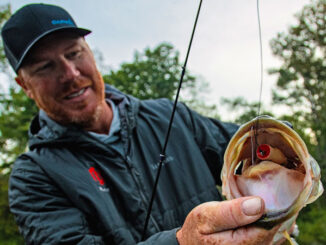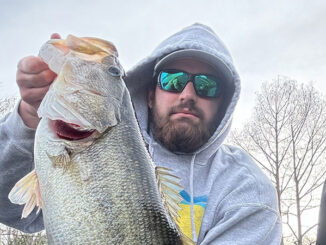
Opportunities for kayak bass-fishing abound
They’re not sparkly or fast, but kayaks make excellent bass-catching machines. With the ability to be rigged with nearly all the accessories and comforts of their larger and much more expensive cousins, kayaks are becoming a mainstay of weekend warriors and serious bass anglers alike. With bass available in almost all areas of Louisiana except the extreme coastal regions, kayak anglers are finding unlimited areas to fish for these hard-fighting acrobats.
Depth finders, livewells, Power Poles, padded decks, tackle storage and even trolling motors can be added to fishing kayaks to make them rival your favorite pro angler’s bass rig.
Speaking of pro bass fishing, there’s a reason the famed Bassmaster Classic tournament has been held in Louisiana six times. We have the bass. Kevin Van holds the record for the heaviest Bassmaster Classic weight (5-fish daily limit): 69 pounds, 11 ounces caught in the Lake Salvador area in 2011.
Due to the increasing popularity of kayak bass angling, three major national tournament series are held annually. The YakAttack KBF National Championship, The Hobie Bass Open Series, and, the new this year, Huk Bassmaster B.A.S.S. Nation Kayak Series. All of these tours hold regional qualifiers, culminating in a championship tournament at the end of the season. Although KBF held its 2019 championship in the Shreveport-Bossier area and will hold a South-Central Regional final in Monroe in 2020 on a yet-to-be-determined date. These are serious fishing tournaments with cash payouts in the multi-thousands of dollars.
Even if you have no desire to participate in competitive kayak fishing, you can easily pick nearly any area of Louisiana to pursue bass in a kayak. The mid-to-northern reaches boast a variety of lakes and rivers that provide excellent bass fishing for kayak anglers. The southern and some coastal areas have bayous and marshes that teem with hungry bass.
Many of the larger lakes and impoundments hold true, lunker-size bass tipping the scales with double-digits. Familiar names like Lake D’Arbonne and Caney Lake have easy kayak access and great bass fishing. These two lakes, along with Lake Valentine, have produced eight of 10 biggest Louisiana bass. Caney accounts for, including the state record, a 15.97-pound fish. Many of these lakes have been regularly stocked with a variety of gamefish and bait species to enhance the populations and fishing opportunities.

Of course, there is also storied Toledo Bend Reservoir, along with others like Lake Chicot and Poverty Point Reservoir, which are all productive bass fishing areas that kayak anglers can fish. Most of these bodies of water are full of creeks, draws and drains that carve out small pockets and fingers, with many varied coves that are great for exploring with a kayak.
In the southern end of Louisiana, many areas have seen an influx of freshwater that have spread bass populations into areas where they have never been — or at least haven’t been for many years. Many areas of the Pontchartrain Basin fit this bill. While bass have always been caught on the northern side of the lake and on the fringes around the south shore, hurricane protection projects, coupled with multiple openings of the Bonnet Carre Spillway in recent years, has freshened up the marsh in many areas that were previously much more saline. This blurring of the species line has anglers reaping the rewards. It is not uncommon to catch speckled trout, redfish, flounder and bass and freshwater catfish all in the same location. It is generally more common to find bass, freshwater cats and redfish in the same areas, since reds are more tolerant of freshwater than speckled trout. However, trout can often be found in nearby deeper water.
The good news is that there is not a huge learning curve to go from catching most inshore saltwater species to catching bass. Bass and redfish seem to have the most characteristics in common. In fact, most redfish lures are born out of the bass-fishing world, with the main difference being the use of stronger materials, wire and hooks due to the generally larger size, strength and crushers with which redfish are armed. That being said, topwater baits, spinnerbaits, soft plastics and even live shrimp work equally well on bass or redfish. With minimal changes, anglers can adapt their lures and techniques to maximize their chances of catching both species.
Bass are thriving in these now-brackish waters. If you normally fish for trout and reds, your current rods and reels are pretty well-suited for bass. If you’re primarily a bass fisherman, you should consider upgrading to heavier rods and line. Bass tend to orient to cover more than trout and reds, so pay particular attention to any stumps, grass beds or other structure you encounter.
Whether you want to try your hand at bass tournament angling, catch a few for dinner or catch-and-release, a kayak makes a great platform to chase bass. Louisiana offers a multitude of water types with easy kayak access where anglers can catch a limit of school-size bass or possibly the trophy of a lifetime.
National Kayak Bass Tournament Information:


